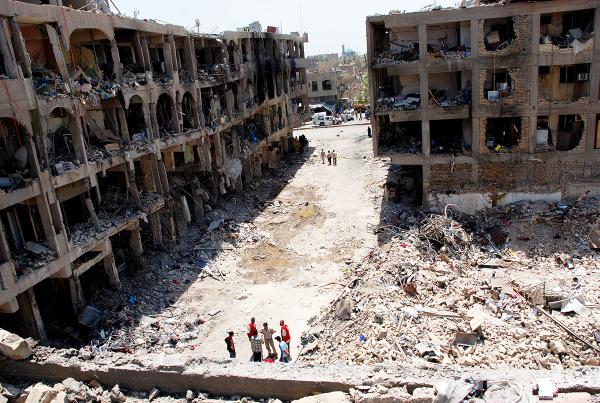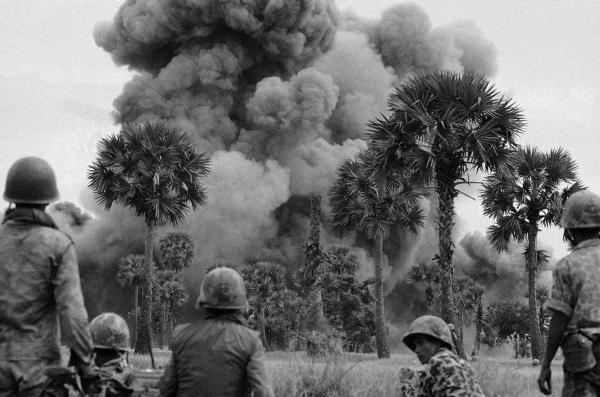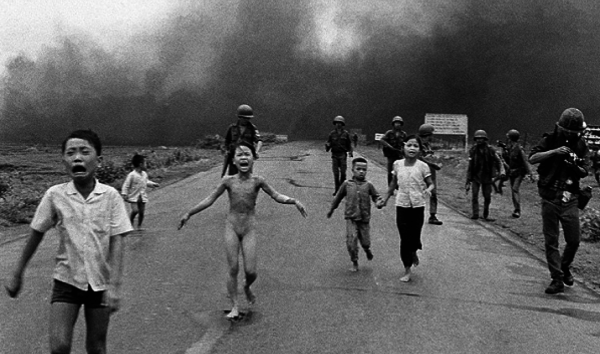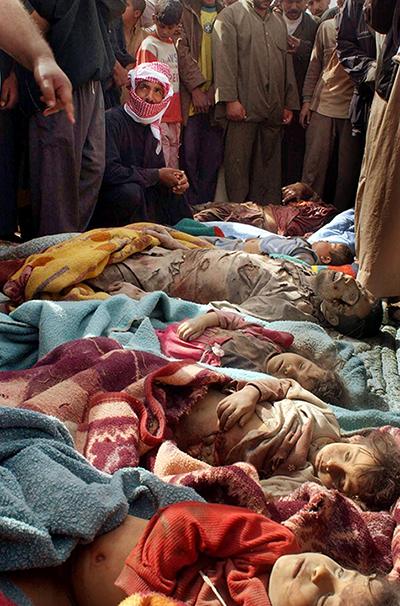
Central Baghdad, Iraq, July 30, 2007, after a bombing. About 8 million Iraqis, nearly a third of the population, need immediate emergency aid because of the humanitarian crisis caused by the Iraq war. Photo: AP
On Monday morning, October 10, Russian military forces in Ukraine launched a wave of aerial attacks against Kyiv—Ukraine’s capital—and ten other cities, reaching far beyond the current war zone in the south and east, to areas where in recent months people had begun to resume more or less normal lives.
A Ukrainian official said that 30 percent of Ukraine’s energy infrastructure had been hit, raising the specter of people losing heat as winter approaches. Apartment buildings, businesses, offices and streets were also hit. At least 20 people were killed and over 100 injured. In some places water systems couldn’t run because of the power outages. All this created yet more fear, hardship and misery for millions of war-weary civilians.1
The rulers of the U.S. and its NATO allies in this war—who are waging a proxy war with Russia on Ukraine’s territory to determine which imperialist powers will dominate Central Asia and Europe—responded to the Russian attacks with a flood of statements of “shock” and “outrage,” including accusations of “war crimes”2 and promises of both prosecution and retribution.3 Biden said this attack showed Putin’s “utter brutality.” The Secretary of the U.S. Army said targeting of civilian infrastructure was “horrific.” French President Emmanuel Macron declared Russia’s attacks to be “a profound change of the nature of this war.” Even the newly elected fascist government of Italy weighed in, declaring that it was “horrified by the cowardly missile attacks.”4
From these statements you would get the impression that Russia’s attack had reached new, never-before-seen heights of savagery, crossing a line that no other “great power” would even think of violating. But what does the U.S. do when it goes to war with another country? The answer is—it commits crimes on a vast scale and on an unrivaled level of brutality and depravity.

USA: Still Number One in War Crimes

In 1945, the U.S. dropped one atomic bomb each on the militarily insignificant Japanese cities of Hiroshima and Nagasaki. The bombs together killed approximately 200,000 people. In other words, the U.S. killed over 20,000 people in those two raids for every one person killed in the Russian raids—which, again, to the extent that they consciously targeted civilians, were indeed war crimes.
This despicable crime began what the U.S. liked to call “the American Century”—that is, the imperialist parasitical domination of the United States over most of the rest of the world. And massive bombing of civilians was a feature of it. Let’s look at the list:
Korea, 1950-53

From a series of U.S. Army photos depicting the summary execution of 1,800 South Korean political prisoners over three days in July 1950 carried out by the U.S.-installed puppet Syngman Rhee.
In 1950, the U.S. went to war in Korea. Air Force General Curtis LeMay bragged later that the U.S. “burned down every town in North Korea anyway, some way or another, and some in South Korea too…. Over a period of three years or so, we killed off—what—twenty percent of the population of Korea....”5 Pyongyang, a city of 500,000 in 1950, reportedly had only two buildings fully intact by the end of the war.
Laos, Cambodia and Vietnam, 1961-75
A dozen years later, the U.S. and its allies waged an even more horrific war in Indochina against Vietnam, Cambodia and Laos. In Laos, a country of 2 million people, mainly peasants, which wasn’t even directly involved in the war, the U.S. dropped 2 million tons of cluster bombs—250 million cluster sub-munitions6—or about 100 bomblets for every Laotian.

Smoke rises from bombs dropped by U.S. planes near the Cambodian capital of Phnom Penh, July 25, 1973. Photo: AP
The U.S. bombing campaign in Cambodia made farming impossible, forcing millions of peasants to flee to desperate poverty in the capital city of Phnom Penh, whose population doubled in four years. 7
Vietnam: Kill Anything That Moves
But the greatest horror was in Vietnam. Large parts of the South (which the U.S. was supposedly “defending”) were declared “free-fire zones” where troops or pilots were authorized to “kill anything that moves.” In the North, dikes and dams were bombed to cause massive flooding. In total, the U.S. dropped 7,662,000 tons of explosives on one small country. By comparison, U.S. forces dropped a total of 2,150,000 tons of bombs in all theaters of World War 2. By the end of the Vietnam war in 1975, the U.S. had killed 2 million civilians, and the countryside was pockmarked with bomb craters, scorched by napalm, and saturated by (according to the U.S. itself) 11 million gallons of Agent Orange, a deadly herbicide that causes all kinds of diseases as well as birth defects.

People with severe flesh burns after napalm attack, June 8, 1972. Photo: Wikipedia
Think about it: 2 million people, in Vietnam alone!!! And now these people like Biden claim to be “shocked” and demand war crimes trials. With the sole exception of the trial of William Calley, who commanded a company of troops to carry out the My Lai massacre of over 500 civilians in a single morning, the only war crime “trial” ever held in the U.S. was carried out by the veterans of its own war, who testified in a tribunal that they organized themselves to the American-ordered crimes that they either witnessed or carried out in Vietnam.8
Iraq 1991-2003
But that was a long time ago, right? Surely the “good ole USA” has summed up these terrible events and fights differently now?
Wrong! Look at the U.S.’s repeated wars with Iraq (aimed at stabilizing and consolidating control of the strategic Middle East).
U.S. Devastates Civilian Infrastructure—Electricity, Water Pumping and Water Purification—of Iraq, Leading to Deaths of Hundreds of Thousands of Children

1991–in a Baghdad hospital, one of hundreds of thousands of Iraqi infants suffering from diarrhea as a result of the destruction of the country's water and sanitation system. Photo: Special to revcom.us
When the U.S. invaded Iraq in January 1991, it started with a 43-day nonstop campaign of bomb and missile attacks. 109,876 combat sorties dropped some 250,000 munitions—6,000 a day.9
The U.S. bragged about its “smart” munitions that could be focused on purely military targets and avoid civilians and civilian infrastructure. But what they don’t mention is that U.S. war planners consciously saw the destruction of civilian infrastructure—electric plants, water purification and pumping stations, dams, railroads, etc.—as key to victory.
According to the Washington Post:10
their intent was to destroy or damage valuable facilities that Baghdad could not repair without foreign assistance. Many of the targets … were chosen only secondarily to contribute to the military defeat [of the Iraqi army.] Military planners hoped the bombing would amplify the economic and psychological impact of international sanctions on Iraqi society. …
… "When they discuss warfare, a lot of folks tend to think of force on force, soldier A against soldier B," said another officer who played a central role in the air campaign but declined to be named. Strategic bombing, by contrast, strikes against “all those things that allow a nation to sustain itself.” [Emphasis added]

A family in Iraqi Kurdistan washing clothes in polluted water, 1991. Before the 1991 Gulf War, 96 percent of Iraqis had access to abundant supplies of safe drinking water. Three years later less than half had such access. Photo: Special to revcom.us
The U.S. was quite successful at this:
Between the sixth and seventh days of the air war, the Iraqis shut down what remained of their national power grid. "Not an electron was flowing," said one target planner. …17 [of Iraq’s 20 electric generating plants] were damaged or destroyed in allied bombing. Of the 17, 11 were judged total losses.
And the impact on the people was staggering:
The worst civilian suffering, senior officers say, has resulted not from bombs that went astray but from precision-guided weapons that hit exactly where they were aimed—at electrical plants, oil refineries and transportation networks.
A Harvard public health team, after visiting Baghdad, told the Post that
the lack of electrical power, fuel and key transportation links in Iraq now has led to acute malnutrition and "epidemic" levels of cholera and typhoid. In an estimate not substantively disputed by the Pentagon, the team projected that “at least 170,000 children under five years of age will die in the coming year from the delayed effects” of the bombing.
February 13, 1991: The Targeted Destruction of the Amiriyah Neighborhood Bomb Shelter—Over 400 Civilians Killed

Amiriyah shelter in Iraq bombed by U.S. killing 408.
But the U.S. didn’t just target civilian infrastructure—their “smart bombs,” helicopter gunships and planes were used to massacre civilians as well. According to Forces.net, “Civilian deaths resulting from the conflict are estimated at between 100,000 and 200,000.”
Here is a chilling example of a massacre of Iraqi civilians by the U.S.: In the middle-class neighborhood of Amiriyah, Shelter #32 was a respite from the terror—dug so deep and well it was said it could withstand a nuclear blast. It also had its own electrical system, so people were constantly in and out to take advantage of that, since U.S. bombing had devastated Baghdad’s power system. Kids would hang out there to play.
On February 13, as Al Jazeera describes: “a roar tore through the quiet neighbourhood when two laser-guided bombs slammed down on the concrete and steel structure, piercing the bunker’s roof and incinerating hundreds of civilians beyond recognition.” Neighbors rushed to help; one woman said “When I reached the shelter I heard the screams of the people who wanted to get out. By 10 am the voices had stopped – no one was screaming.”
At least 408 people died.
The U.S. falsely claimed that the shelter was a military command center, and that they had “no idea” civilians were there—even though the neighborhood was under constant satellite surveillance, and women and children were in and out of the shelter at all hours of the day. 11
Deadly Sanctions Lead to Malnutrition, Disease and Death for Half a Million Children

Having destroyed “all those things that allow a nation to sustain itself,” the U.S. followed it with heavy sanctions, preventing Iraq from importing the supplies needed to repair their infrastructure, or from selling enough oil to have the foreign currency to buy imports in any case.
Over the course of the next 10 years, as then-U.S. ambassador to the UN Madelaine Albright admitted on 60 Minutes, an estimated 500,000 children would die—Albright’s assessment of this was that “it was worth it.”
2003: The U.S. Again Invades Iraq

Iraqis look at the bodies of their loved ones killed during a U.S. raid 50 miles from Baghdad, March 2006. Photo: AP
Then, on top of all this, in 2003 the U.S. invaded again, (on the false pretext that Iraq was preparing to attack the U.S. with “weapons of mass destruction” which did not exist).
The U.S. launched a “Shock and Awe” attack on the capital city of Baghdad and its 6 million civilian inhabitants. In the first days of the war, “1,300 missiles and bombs were dropped on Iraq, most of them on Baghdad.”12 It virtually levelled the city of Fallujah, population 300,000, because it was a center of resistance to U.S. occupation, destroying 36,000 houses and killing between 4 and 6 thousand Iraqis. It set up torture centers like the Abu Ghraib prison. It fired on innocent gatherings of people from helicopter gunships.
By the end of the official U.S. occupation in 2011, it wasn’t just the infrastructure—Iraq itself was virtually destroyed as a functioning nation-state, fractured by internal turmoil, wracked by poverty and disease. It has yet to recover.
Barbaric “Customs” of a Savage Nation: U.S. Military Bombings of Weddings!
In the last few decades, the U.S. and its allies have amassed a horrifying toll of bombings of wedding parties, as well as school buses, hospitals and other targets filled with innocent civilians. A few examples:
- Afghanistan, July 2008, a U.S. missile hit a convoy of people traveling to a wedding in Nangarhar province, killing 47, including 39 women—one of whom was the bride—and children. Another 10 people were missing and presumed dead. All casualties were civilians.
- Afghanistan, August 2008, a U.S. helicopter gunship opened fire on what it thought was a meeting of Taliban militants in Herat province, but was actually a gathering of local peasants. The U.S. at first acknowledged 5-7 civilians as “collateral damage” but in the face of UN reports of 90 deaths finally admitted to 33.
- Afghanistan, November 2008, a missile launched by a U.S. aircraft hit a wedding party in Kandahar province, killing 40 civilians and wounding 28 others.
- Yemen, December 2013, a U.S. drone fired four missiles at people traveling to a wedding in Bayda province because a handful were thought to be in al-Qaeda—at least 17 people were killed, and at least 12 of them were innocent civilians. The Los Angeles Times wrote “In the gruesome aftermath, scorched vehicles and body parts were left scattered on the road. The incident illustrated the fact that many of the militants have tribal connections that make them likely to take part in village events, such as wedding celebrations.”
- Yemen, October 2016, the U.S.-backed Saudi military used advanced U.S. “guided” bombs to attack a large funeral in the city of Sana’a, killing at least 140 people and wounding 550. A local health official described the aftermath as “a pool of blood.”
- Yemen, April 2018, the Saudis used the same type of U.S. bomb to attack a wedding in the Hajjah governate, killing at least 33 people, including the bride. The majority of the dead were reportedly women and children. Survivors said that Saudi jets continued to circle overhead after the attack to prevent first responders from reaching the victims.
On July 5, 1852, the formerly enslaved abolitionist leader Frederick Douglass stated that the United States was guilty of “crimes that would disgrace a nation of savages.” These words ring truer than ever 170 years later.
A Consistent Record
And it is the same story, the same basic methods with new twists (like blowing up hospitals, or bombing school buses) that characterize every U.S. military venture. It is no exaggeration to say that the U.S. military has the blood of millions on its hands and has laid at least seven countries to complete ruin just since World War 2. And this will continue to be the nature of their “war-fighting methods” unless and until their machinery of death is defeated, broken up, and thrown in the dustbin of history.
Bob Avakian: Free Yourself from the GTF!